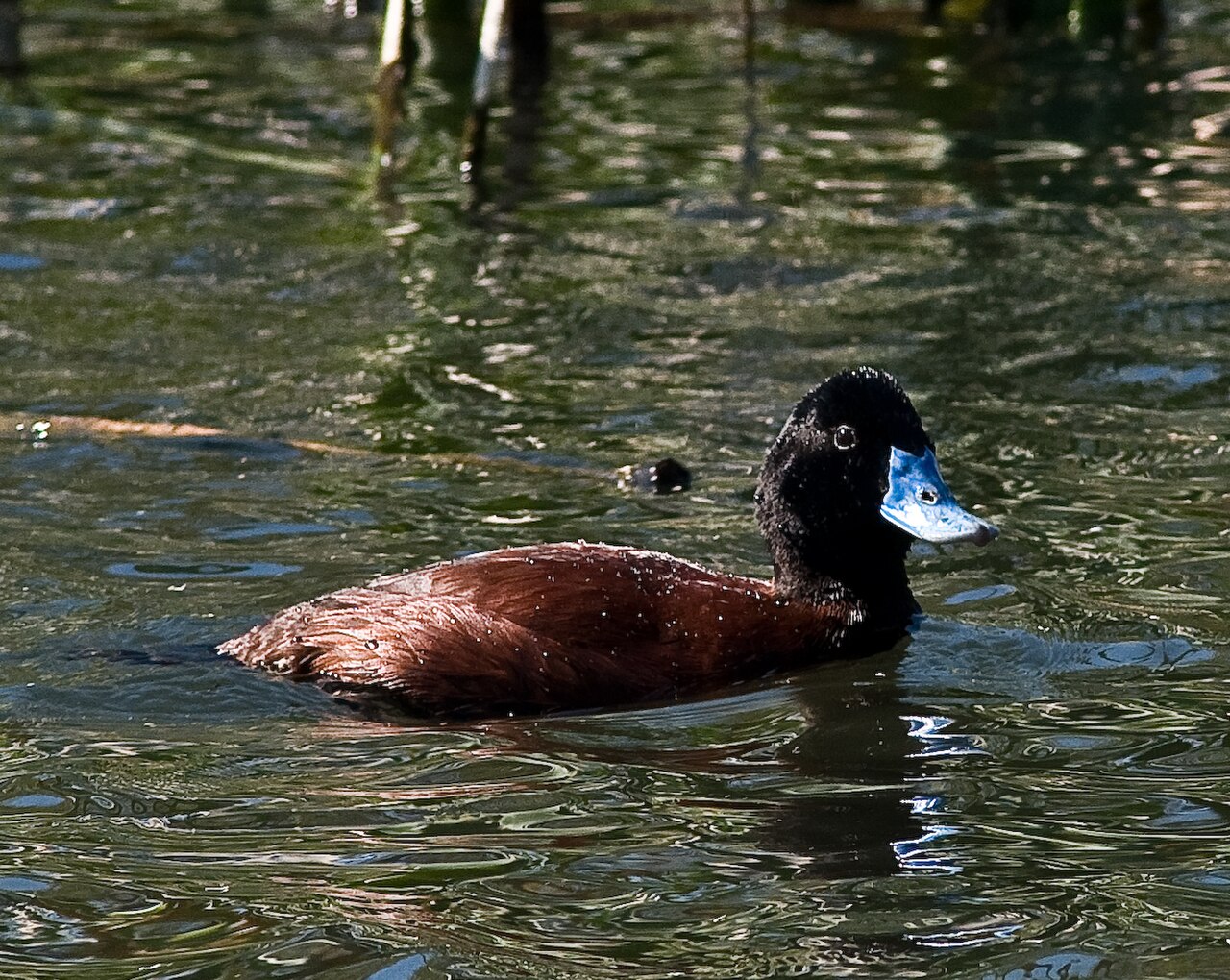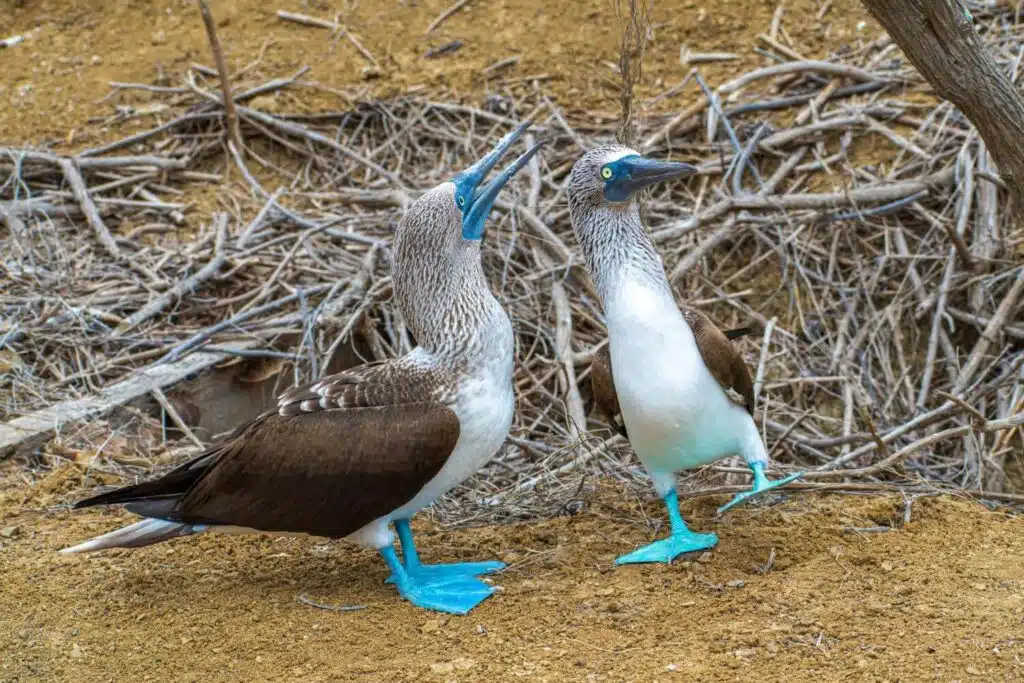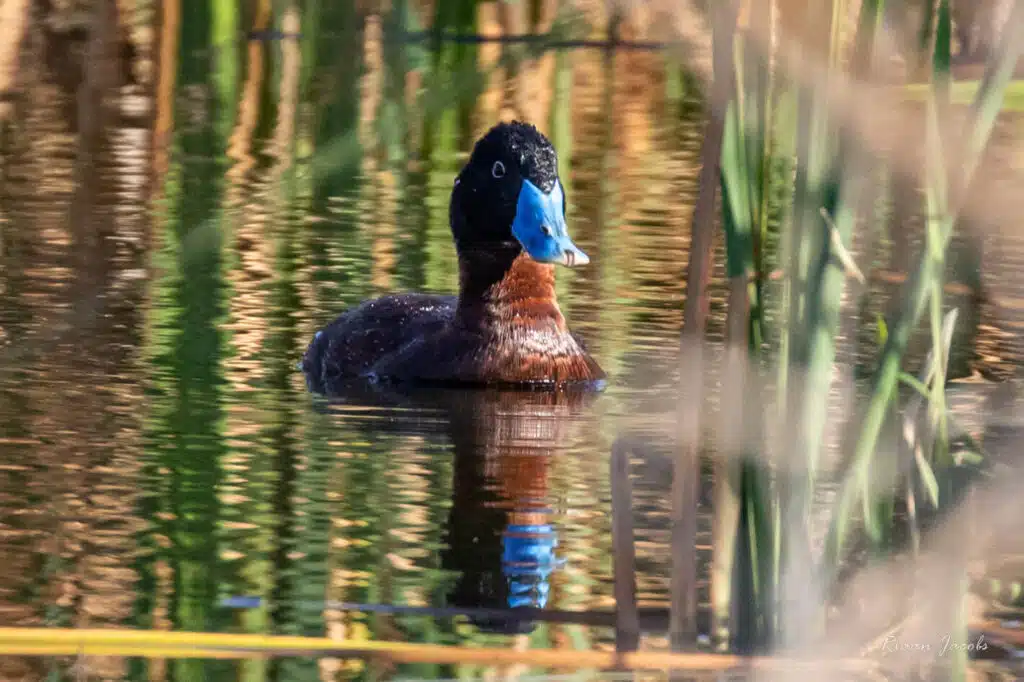Some of the most intriguing birds in the world have blue beaks. Certain species have blue beaks throughout the year while others only have blue beaks for a short period, such as the breeding season.
Differences between the sexes also mean either male or female birds can have blue beaks.
Some species are even known to have more vivid colors, including the beak, during the summer.
Migratory or sedentary, birds with blue beaks are found all around the world. From small birds living in woodlands to ducks only found in brackish waters, blue beaks are specific to different species.
Some of these birds with blue beaks are related and may even inbreed. Others are independent species without any subspecies and only specific to certain regions of the world.
Here are some of the typical birds with blue beaks that exist today.
Table of Contents
1. Northern Pintail

Scientific name: Anas acuta
Beak: Blue, blue-gray, and black
Distribution areas: Canada and Alaska, The United States, Europe, and Asia
Subspecies: No subspecies
The Northern Pintail often comes in a blue nuance bill. This species has Northern distribution and breeding areas that expand to Canada’s Northern Territories and Alaska.
The species also move Southwards to US states, where it may not breed.
Northern Pintails prefer to live in open waters rather than living in woodlands.
This is where they spend much of their time and where they go underwater for food. Rhizomes are their main food source in water.
Northern Pintails may also eat fruit and seeds as they travel.
While this species has few predators in lakes, ponds, and marshes it inhabits, it may become vulnerable to predation as it travels. Foxes are among its main predators.
2. Blue Grosbeak

Scientific name: Passerina caerulea
Beak: Blue and gray
Distribution areas: North and Central America
Subspecies: 3 subspecies in North America, 6 subspecies in Central America
Blue Grosbeak is a species with an upper blue beak. It has Southern US distribution across North America.
While not all Blue Grosbeaks in North America migrate, some populations in Southern Florida are known to migrate.
Outside the US, populations in Baja California also migrate. Breeding sights include all Southern US states.
The only non-migratory Blue Grosbeaks live in Mexico.
This type of blue beak bird eats all types of insects. This includes various species of spiders plus the occasional alternative foods such as grains and fruit.
3. Red-footed Booby

Scientific name: Sula sula
Beak: Blue and pink
Distribution areas: Tropical areas
Subspecies: 3 subspecies across The Pacific and The Atlantic
A white, brown, and gray morph are all specific to the Red-footed Bobby. These types of colorful birds come with blue beaks and often have red legs.
Found around the world in tropical areas, birds of this species show a tendency towards colonization, especially in the breeding season.
They choose specific and safe coastal areas for their breeding seasons.
Very good at flying, these species inhabit even remote islands of The Pacific and Atlantic Oceans.
Feeding habits are influenced by their maritime habitat. They dive after small fish and mollusks. Some of the largest birds of this species end up reaching a size of around 60 inches.
4. Blue-billed Duck

Scientific name: Oxyura australis
Beak: Bright blue
Distribution areas: Australia
Subspecies: None
This type of duck is found in the Southern and Southwestern regions of Australia. These are temperate climates where the species finds various water sources such as canals to live on.
A blue bill is specific to the species. It changes colors from light to dark blue, depending on the breeding season.
A chestnut brown color is specific to this duck. Its color also changes to gray depending on the occurrence of the breeding season.
Some of the largest Blue-billed Ducks reach a size of around 16 inches.
Seeds and plants are its main food source but a diminishing habitat means food sources are getting scarce for the species.
5. Indigo Bunting

Scientific name: Passerina cyanea
Beak: Blue, brown
Distribution areas: Eastern US states, Central America
Subspecies: 2 subspecies
A considerable color change is specific to the plumage of the male Indigo Bunting, the true blue Indigo Bunting.
Males typically have a brown-gray color. This color changes to vibrant blue during the mating season as a means for the male to attract females.
Such color changes are also applicable to the beak of the species.
This small bird shows high territorial variation, depending on the season. It moves from North America to South America during the winter.
Birds of this family often migrate by night. They avoid predators with nighttime flying patterns and they may use the moon and the stars as guidance.
This species is solitary but it feeds in groups during the breeding season.
Some of its typical dietary choices include spiders and caterpillars.
A small species which rarely reaches a size of 5 inches, the bird is subject to predation of species that can climb trees and shrubs. Cats are among their most common predators.
6. Common Chaffinch

Scientific name: Fringilla coelebs
Beak: Blue-gray
Distribution areas: Europe, Africa, Asia
Subspecies: 11 subspecies
Found across much of Europe and the Northern part of Africa, The Common Chaffinch is a species of finch where males exhibit a blue-gray beak.
With multiple subspecies across the continent, it’s only the local variants of The Common Chaffinch that come with a blue beak.
Amon these, there’s the male Common Chaffinch in Madeira and the male bird in La Palma.
Most subspecies of this bird are characterized by gray or brown coloring with a white band seen on the wings.
This species lays up to 5 eggs at once. Its eggs are always subject to predation.
Other birds, cats, and even squirrels are listed among the typical predators of the species.
7. Ruddy Duck

Scientific name: Oxyura jamaicensis
Beak: Bright blue, gray
Distribution areas: North America
Subspecies: No subspecies
Growing to a size of up to 17 inches, Ruddy Ducks are among the species native to The US, Canada, and Mexico.
These ducks exhibit color changes which are why they have blue beaks. However, unlike other ducks, their beaks change colors with the season, not with their breeding periods.
Ducks of this species are the most colorful in the summer when they exhibit bright blue beaks and white cheeks.
A gray-to-brown color is specific to the species in the winter.
Some differences also exist between males and females as males are likely to have colorful blue beaks.
Both males and females migrate during the winter months.
8. Blue-footed Booby

Scientific name: Sula nebouxii
Beak: Blue
Distribution areas: Gulf of California, Pacific coast of Southern and Middle America
Subspecies: 2 subspecies
The large Blue-footed Booby is a species with a blue beak and blue legs. This coloring inspires the name of the species often found around The Gulf of California.
These large species grow to a wingspan of up to 5 feet.
Blue-footed Booby birds are adapted to eat ocean fish. They can dive directly after fish.
Unlike other diving birds with blue beaks, Blue-footed Booby birds can also swim underwater for a few seconds, which comes with greater chances of catching fish.
Mackerel is one of the specific species this bird eats.
The dive of the bird into the water is spectacular. Adult Blue-footed Booby birds can dive from tens of feet.
9. Boat-billed Heron

Scientific name: Cochlearius cochlearius
Beak: Blue, gray
Distribution areas: Central America, South America
Subspecies: 5 subspecies
A blue beak and blue wings are specific to The Boat-billed Heron. This characteristic color of males helps the species stand out.
The beaks of the species are sensitive, which means it helps them handle prey.
The long colorful beaks of the species aren’t easily spotted as this species of bird is nocturnal.
Boat-billed Herons only come out for food at night, spending much of the day resting.
The species rest on trees and shrubs as well as on other types of high elevation structures.
Found around tropical areas, it prefers marshes and lowlands.
The species may be solitary at times but most Boat-billed Herons live in large groups.
The diet of these long blue beak birds is comprised of crabs, amphibians, mollusks, and even small mammals and rodents.
10. Scarlet-rumped Tanager

Scientific name: Ramphocelus passerinii
Beak: Blue, gray
Distribution areas: Tropical regions
Subspecies: 2 subspecies
Colorful patches contrast the mostly black appearance of The Scarlet-rumped Tanager.
This is a species with a black body and a red or orange section as well as a blue beak.
Unlike other species which have coloring differences, it’s the female Scarlet-rumped Tanager that has a blue beak.
Growing up to a size of 6 inches, the bird is found in countries such as Costa Rica and Mexico.
It lives at different elevations up to several thousand feet and it can be spotted in groups.
Small living groups are characteristic of The Scarlet-rumped Tanager as opposed to the solitary living habits of other species.
These birds appear in several broods throughout their range.
Its feeding habits are based on various types of small fruit which differ from one region to another.
11. Lake Duck

Scientific name: Oxyura vittata
Beak: Blue
Distribution areas: South America
Subspecies: No subspecies
A common duck in South America, Lake Ducks are also known as Argentine Blue-billed Ducks based on the blue color of their beaks.
The duck is medium-sized and measures around 15 inches with some of the largest types of ducks of the species reaching a size of 18 inches.
The name of the species is based on its blue beak and its common occurrence in Argentina. The duck is native to Argentina, Chile, and Brazil.
As a duck, this species is found in different types of water in South America.
It lives in areas with plenty of vegetation as it is believed it feeds on rhizomes, along with seeds, and various types of wildlife.
The breeding season of the species may differ from one country to another but it generally lasts up until February.
Some of the areas of the species may prompt it to migrate. Freshwater is preferred by these ducks and they may move on to regions along marshes as ideal habitats.
Some ducks of this species may also migrate early for breeding. The season starts with males making specific rattling noises.
12. Andean Duck

Scientific name: Oxyura ferruginea
Beak: Blue
Distribution areas: Andean Mountains range
Subspecies: No subspecies
Similar to Lake Ducks, Andean Ducks may also come in a blue beak and chestnut to dark brown coloring.
The similarity of the duck with other species has long been considered a subspecies. However, Andean Ducks are an independent species with a constant presence around South America’s Andean Mountain Range.
There are small appearance differences in the species, depending on the season, which may be responsible for the confusing status of the duck over the past decades.
This is a duck that changes colors from summer to wintertime.
In the summer, it has a chestnut color and blue beaks. Its beaks turn gray in the winter.
Some of the preferred areas of the ducks include marshes in Western South America. Dense vegetation areas of these marshes are preferred by the ducks.
Dense vegetation areas are preferred by the species for nesting. Females use vegetation o build nests.
The diet of the species also includes roots and grasses. These ducks dive and swim looking for plants.
They also eat all types of insects living around marshes.
13. White-headed Duck

Scientific name: Oxyura leucocephala
Beak: Blue, brown
Distribution areas: Europe, Asia
Subspecies: No subspecies
A species named after its white head, the duck is among the European species with a blue beak.
It ranges Expands from Eastern Mediterranean territories to The Middle East.
Small differences exist between the male and the female White-headed Duck in terms of coloring.
This is a species with a blue beak and a white head only in the case of the male ducks as females have a gray or brown beak.
White-headed Ducks are now endangered through much of their range.
These ducks typically breed in Spain, then move back to their resident areas of Asia. Its breeding grounds are being reduced.
Furthermore, this species also faces inbreeding problems where it becomes a hybrid with other species.
Females of the species can breed with other ducks with blue beaks, such as ruddy ducks.
14. Maccoa Duck

Scientific name: Oxyura maccoa
Beak: Blue, gray, black
Distribution areas: South Africa, East Africa
Subspecies: Unknown
This type of duck is only present in Africa. Eastern states and countries in the Southern parts of the continent are home to this species.
Maccoa Ducks are known for their bright blue beaks and contrasting black heads.
These types of ducks have chestnut dominating color while the underparts of the species have a gray to brown color.
The underparts of the female are brighter.
These types of ducks are found in different types of water. Both freshwater sources and brackish water are among the typical areas of the species.
While similar to ducks with blue beaks in America, Maccoa Ducks are still distinct in key elements of their lives.
For example, these types of ducks can breed both in freshwater and brackish water.
Vegetated areas are preferred as breeding sights, arguably to stay away from predators.
This species is known for favoring bulrush areas as its ideal breeding site.
As it lives in warm climates, this duck species is sedentary. Maccoa Ducks only move when they seek out to find new food sources.
15. Blue Jay

Scientific name: Cyanocitta cristata
Beak: Blue, gray-blue, black, and blue
Distribution areas: East US and East Canada
Subspecies: Northern Blue Jay, Coastal Blue Jay, Interior Blue Jay, Florida Blue Jay
A native species across much of North America, Blue Jays are a species commonly found on the Eastern parts of the continent.
They inhabit large territories East of The Rocky Mountains and are accepted in 4 subspecies, all with different levels of blue on their beaks.
The limits between local subspecies distribution are difficult to establish except for The Florida Blue Jay.
Blue colors are also seen across the patterned appearance of the bird. White is specific to its underparts.
This species is mostly found around woodlands. It prefers mixed woodlands and oak woodlands.
In specific areas of the country, such as in Florida, Blue Jays live in Florida scrub and pine woodlands.
16. Steller’s Jay

Scientific name: Cyanocitta stelleri
Beak: Blue, black, and blue
Distribution areas: Western North America
Subspecies: 18 subspecies across North and Central America
Similar to Blue Jays and sometimes even wrongly referred to as Blue Jays, Stellere’s Jay is a type of blue bird with a blue beak across Western North America.
Its range extends into Western parts of Central America. Some strays may even be found in the Northern limits of South America.
With more subspecies than Blue Jays, Steller’s Jay may also hybridize Blue Jays.
This bird grows to a size of up to 12 inches and is dominated by blue colors even on the chest.
Its head has a darker color, mainly gray to black or gray to brown.